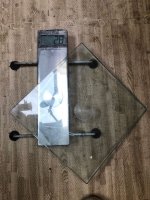Windshield adhesive is probably going to do a good job. The “UV” represents the type of curing process. It does not necessarily mean it is UV resistant.
You do want an adhesive that remains rubbery. All that flexing will destroy a bond that is rigid. I would not use epoxy for that reason.
My first inclination is to use E600 adhesive. It is a styrene based adhesive that remains flexible. It is like silicone adhesive on steroids. It is available in the big box stores like Home Depot, in hobby stores like Michaels and online from Amazon.com.
Amazon carries this product in squeeze tubes and caulking type tubes. The others only carry the squeeze tubes.
This stuff cures in exposure to air. If you are just bonding to the perimeter, you will do fine. If you are bonding to areas that will not have access to air, those areas will likely take a very long time to cure.
I like to use small pieces of mirror mounting tape to hold the piece in place, and use the E6000 everywhere else.
Also providing a good bond on non-porous surfaces is the adhesive that is used to glue rear view mirrors to the inside of the windshield. But they come in very small squeeze tubes and it will cost a fortune to glue to a larger surface.
I recently bought a digital scale which reads to the tenth of a pound. I don’t remember what I paid for it, but certainly under $40.00 and more likely under $30.00.
Unless you are emotionally attached to the scale, I’m not sure that making a repair is entirely sensible.

